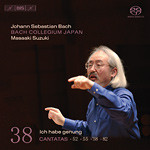
Cantatas (Vol 38) BWV52, BWV82 (bass version), BWV55 & BWV58
 $35.00
Out of Stock
$35.00
Out of Stock2-6 weeks add to cart
J.S. BACH
Cantatas (Vol 38) BWV52, BWV82 (bass version), BWV55 & BWV58
Carolyn Sampson (soprano) Gerd Tark (tenor) Peter Kooij (bass) / Bach Collegium Japan / Masaaki Suzuki
[ BIS / Hybrid SACD ]
Release Date: Tuesday 1 January 2008
This item is currently out of stock. We expect to be able to supply it to you within 2 - 6 weeks from when you place your order.
"Easily the best-known piece here is Ich habe genug (BWV 82). Peter Kooij's tender, yearning account is more modestly stated than versions by his more extrovert rivals. Gerd Türk, assisted by Suzuki's beautifully shaped phrasing, makes a stronger case for the austere Ich armer Mensch (BWV 55) than any rival version that comes to mind."
(BBC Music)
Hybrid/SACD - playable on all compact disc players
"Easily the best-known piece here is Ich habe genug (BWV 82). Peter Kooij's tender, yearning account is more modestly stated than versions by his more extrovert rivals. Gerd Türk, assisted by Suzuki's beautifully shaped phrasing, makes a stronger case for the austere Ich armer Mensch (BWV 55) than any rival version that comes to mind."
(BBC Music)
The four cantatas on this recording come from 1726-1727, Bach's fourth year of service at the Thomaskirche in Leipzig. During this time Bach showed a preference for solo cantatas, entrusting the text to a single solo voice. Three of these cantatas are of this type, while the fourth (BWV58) is scored for two voices. We can only speculate as to Bach's reason for using this form of cantata: a shortage of choristers, perhaps, or the availability of especially gifted soloists. It's also possible that Bach was preparing himself, and the choir, for the St Matthew Passion, planned for the Easter of 1727. Bach may also have wished to achieve greater variation in his cantata repertoire, a suggestion supported by the fact that he now more often incorporated instrumental movements. One example is the opening sinfonia of BWV 52, based on a preliminary version of the first Brandenburg Concerto. While Volume 37 in this series focussed on the solo cantatas for alto, as performed by counter-tenor Robin Blaze, this one gives equal space to three other soloists familiar to followers of the series. Ich habe genung, one of the most well-known of all Bach's cantatas, is here performed in the original bass version by Peter Kooij, giving voice to the text's journey from weariness of life to the joyful longing for the hereafter in the lively final movement. Carolyn Sampson interprets BWV 52, in which the falseness of the world is contrasted with the steadfastness of God, and joins Kooij in the dialogue of the duet cantata BWV58. The third soloist, Gerd Türk, performs the remaining cantata for solo tenor, Ich armer Mensch, ich Sündenknecht - a mournful recognition of man's sinfulness and a plea for the mercy of God. The whole is accompanied by the eminent ensemble of Bach Collegium Japan, and infused by the vision of Masaaki Suzuki, as described on German website klassik.com: 'In Suzuki's recordings the listener encounters a Bach full of élan and vitality, completely removed from any overly intellectual, protestant-puritan theoreticians, but instead opposing such an approach. Equally impressive as the architecture of Bach's music is the liveliness and impulsiveness, not to say spontaneity, which it projects.'
Tracks:
Falsche Welt, dir trau ich nicht, BWV52
Ich habe genung, BWV82 (bass version in C minor)
Ich armer Mensch, ich Sündenknecht, BWV55
Ach Gott, wie manches Herzeleid, BWV58



